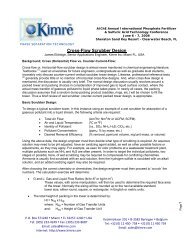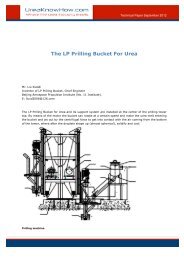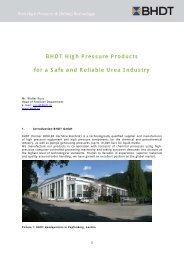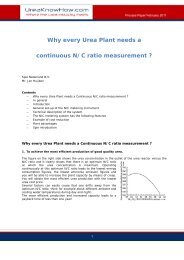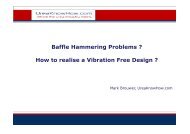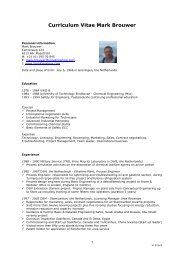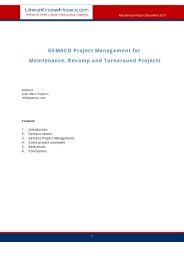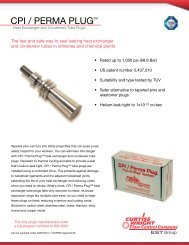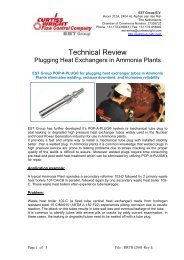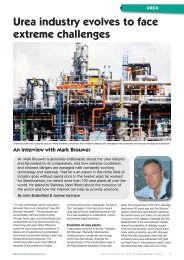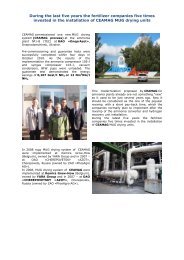download the PDF - UreaKnowHow.com
download the PDF - UreaKnowHow.com
download the PDF - UreaKnowHow.com
Create successful ePaper yourself
Turn your PDF publications into a flip-book with our unique Google optimized e-Paper software.
Cannerweg 123<br />
6213 BA Maastricht<br />
The Ne<strong>the</strong>rlands<br />
Reliable Pressure Measurements<br />
in <strong>the</strong> Urea High Pressure Syn<strong>the</strong>sis Section<br />
Introduction<br />
SKW Pieteritz in Germany has developed a reliable pressure transmitter for <strong>the</strong> high pressure<br />
syn<strong>the</strong>sis section in any urea plant. This pressure transmitter has been developed as part of <strong>the</strong><br />
Innovative Overpressure Protection System for high pressure urea syn<strong>the</strong>sis sections, which is<br />
presented during <strong>the</strong> AICHE Ammonia Safety Conference 2012 in Chicago and offered by <strong>the</strong> Safety<br />
Valve producer LESER in Germany. It has been agreed between <strong>the</strong> parties involved that<br />
<strong>UreaKnowHow</strong>.<strong>com</strong> will offer <strong>the</strong> pressure transmitter itself to urea producers.<br />
To measure in a reliable way <strong>the</strong> pressure in a high pressure gaseous carbamate line, several<br />
challenges are to be encountered: crystallization, erosion and corrosion risks. Also in liquid carbamate<br />
lines <strong>the</strong>se risks are present. Solutions have been found to avoid <strong>the</strong>se risks and <strong>the</strong>se pressure<br />
transmitters are successfully in operation since September 2011.<br />
Challenges to measure pressure in <strong>the</strong> high pressure urea syn<strong>the</strong>sis section<br />
LESER Support Loaded System Safety<br />
Valves are part of <strong>the</strong> Innovative<br />
Overpressure Protection System for high<br />
pressure (HP) urea syn<strong>the</strong>sis sections.<br />
Refer to <strong>the</strong> figure on <strong>the</strong> right side<br />
showing <strong>the</strong> principle <strong>com</strong>ponents of such a<br />
system.<br />
It is important to assure that <strong>the</strong> pressure<br />
measurement system measures <strong>the</strong> same<br />
pressure, which is present at <strong>the</strong> safety<br />
valve. The available length of <strong>the</strong><br />
capillaries is limited and it is critical that<br />
<strong>the</strong> distance between <strong>the</strong> control unit and<br />
actuator on <strong>the</strong> safety valve is limited to<br />
assure a quick enough reaction of <strong>the</strong><br />
safety valve.<br />
Bank address:<br />
RABOBANK Maastricht e.o.<br />
BIC: RABONL2U<br />
P.O. Box 200 Account number: 1402.09.840<br />
6200 AE Maastricht IBAN: NL07 RABO 0140 2098 40<br />
The Ne<strong>the</strong>rlands<br />
<strong>UreaKnowHow</strong>.<strong>com</strong> B.V.<br />
Chamber of Commerce: 52907090<br />
VAT number: NL 850659024.B.01<br />
1<br />
V4 141112
Cannerweg 123<br />
6213 BA Maastricht<br />
The Ne<strong>the</strong>rlands<br />
Pressure measurements:<br />
§ Three (1 of 3)<br />
measurements for<br />
SLS Safety Valve<br />
§ One measurement<br />
(PC1111) for<br />
process control<br />
This means one should measure <strong>the</strong> pressure in <strong>the</strong> high pressure carbamate gas line on which <strong>the</strong><br />
safety valves are installed. Gas phase high pressure carbamate lines are prone to several risks like<br />
crystallization of carbamate and condensation corrosion caused by condensed carbamate.<br />
Crystallization and corrosion risks at <strong>the</strong> diaphragm are avoided by special design and construction<br />
details of <strong>the</strong> manifold and pressure measurement itself.<br />
The pressure transmitter consists of a thin diaphragm, which is sensitive for erosion, corrosion and<br />
mechanical stresses.<br />
Using Hastelloy C 276 is not a good option as within less than<br />
one year <strong>the</strong> <strong>com</strong>plete<br />
diaphragm was dissolved (refer<br />
to <strong>the</strong> picture right).<br />
Using an AISI 316 diaphragm<br />
give a slightly better<br />
performance but still after some<br />
years on stream time <strong>the</strong> thin<br />
diaphragm is severely damaged<br />
(refer to <strong>the</strong> picture left).<br />
Tantalum is a <strong>com</strong>pletely corrosion resistant in carbamate streams, so a perfect material to apply.<br />
Welding such a thin diaphragm is not a good idea as it will cause mechanical stresses, so ano<strong>the</strong>r<br />
reliable way to fix <strong>the</strong> tantalum diaphragm has been developed.<br />
The special design manifold assures that no dead volume is present at <strong>the</strong> diaphragm, so any risk for<br />
crystallization risks is avoided.<br />
2
Cannerweg 123<br />
6213 BA Maastricht<br />
The Ne<strong>the</strong>rlands<br />
Measuring<br />
device<br />
Instrument<br />
connection<br />
Body of<br />
diaphragm<br />
Seal with<br />
diaphragm<br />
The figure above shows <strong>the</strong> principle of <strong>the</strong> pressure transmitter (left) and a picture of <strong>the</strong> tantalum<br />
membrane (right). This pressure measurement has proven to work very reliable and has an accuracy<br />
of 3%.<br />
Applications<br />
The pressure transmitter can be applied for several applications:<br />
1. Measure <strong>the</strong> pressure of <strong>the</strong> urea syn<strong>the</strong>sis section close to <strong>the</strong> safety valves<br />
2. Measure <strong>the</strong> pressure of <strong>the</strong> urea syn<strong>the</strong>sis section at any o<strong>the</strong>r location<br />
3. Use <strong>the</strong> pressure transmitter for a Support Loaded System Safety Valve<br />
4. Use <strong>the</strong> pressure transmitter for an instrumentation safeguard (high pressure switch which<br />
closes for example <strong>the</strong> heat input to <strong>the</strong> HP stripper)<br />
5. Use two pressure transmitters to measure <strong>the</strong> level in <strong>the</strong> urea reactor<br />
SKW Piesteritz operates three Stamicarbon CO 2 stripping plants. In all three lines <strong>the</strong>se pressure<br />
transmitters are installed since September 2011. In two<br />
lines <strong>the</strong> pressure transmitters monitor <strong>the</strong> syn<strong>the</strong>sis<br />
pressure and in <strong>the</strong> third line one pressure transmitters<br />
monitors <strong>the</strong> syn<strong>the</strong>sis pressure and 1 out of 3 pressure<br />
transmitters are used to serve <strong>the</strong> Support Loaded<br />
System Safety Valves.<br />
All pressure transmitters have been working<br />
successfully. The picture on <strong>the</strong> right shows <strong>the</strong> tantalum<br />
membrane after one year of operation.<br />
In <strong>the</strong> turnaround of September 2012, also in <strong>the</strong> o<strong>the</strong>r<br />
two urea lines <strong>the</strong> Support Loaded System for <strong>the</strong> HP<br />
Syn<strong>the</strong>sis Safety Valves are installed.<br />
Reference document:<br />
http://www.ureaknowhow.<strong>com</strong>/urea_j/images/stories/pdf/leser_aiche_2012.pdf<br />
3
Cannerweg 123<br />
6213 BA Maastricht<br />
The Ne<strong>the</strong>rlands<br />
Contact<br />
<strong>UreaKnowHow</strong>.<strong>com</strong> can supply to you <strong>the</strong> design and <strong>the</strong> supply of <strong>the</strong> <strong>com</strong>plete pressure<br />
measurement system (manifold, pressure measurement, certificates etc).<br />
In case you are interested to receive an offer, please contact:<br />
Mark Brouwer<br />
<strong>UreaKnowHow</strong>.<strong>com</strong><br />
T: +31 6 295 76 845<br />
E: mark.brouwer@ureaknowhow.<strong>com</strong><br />
4




